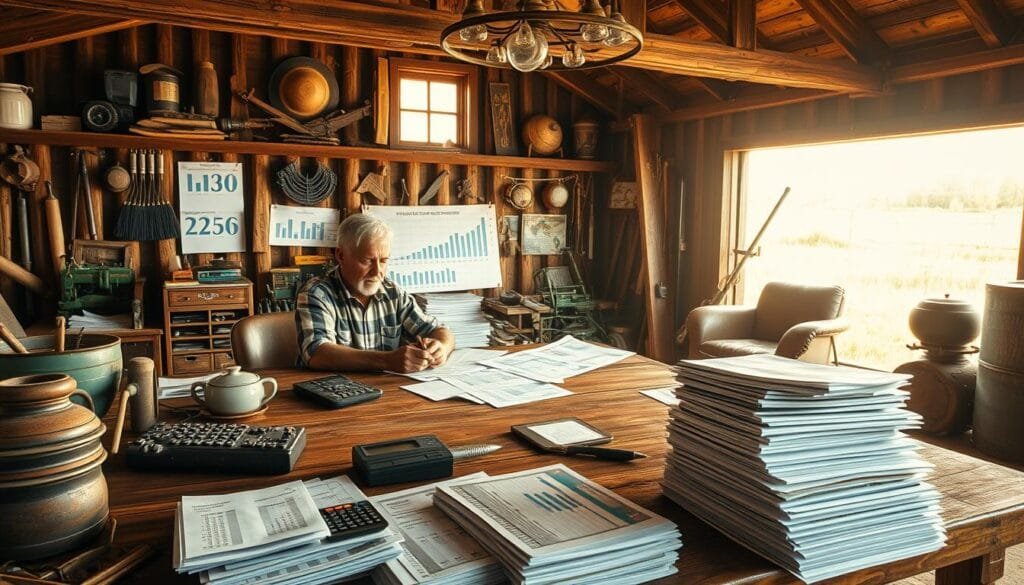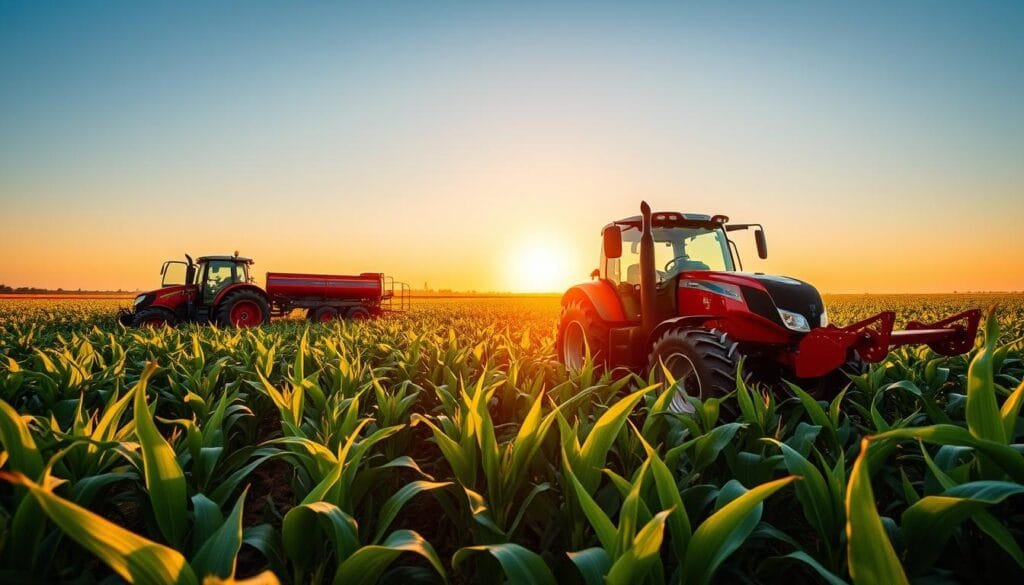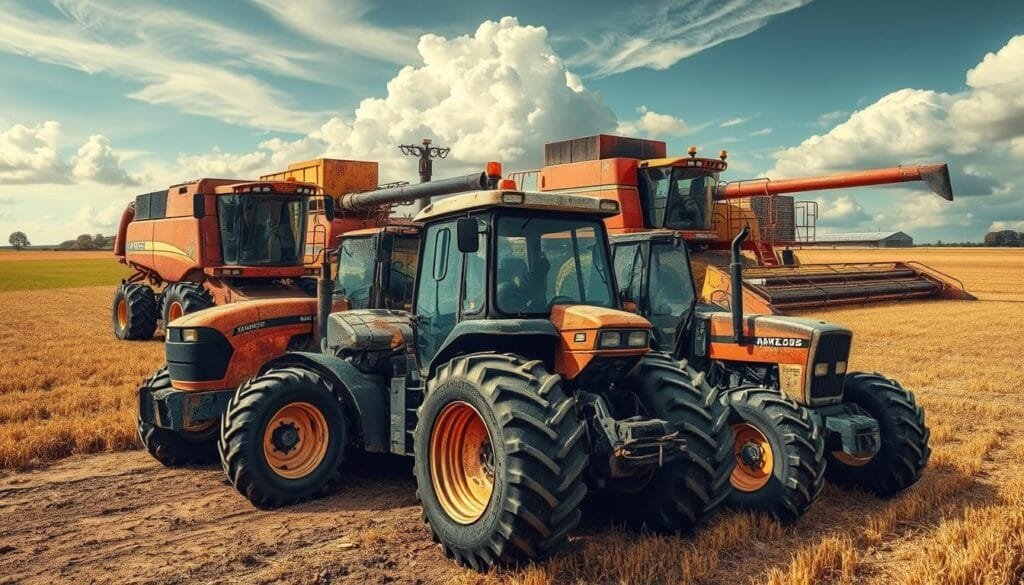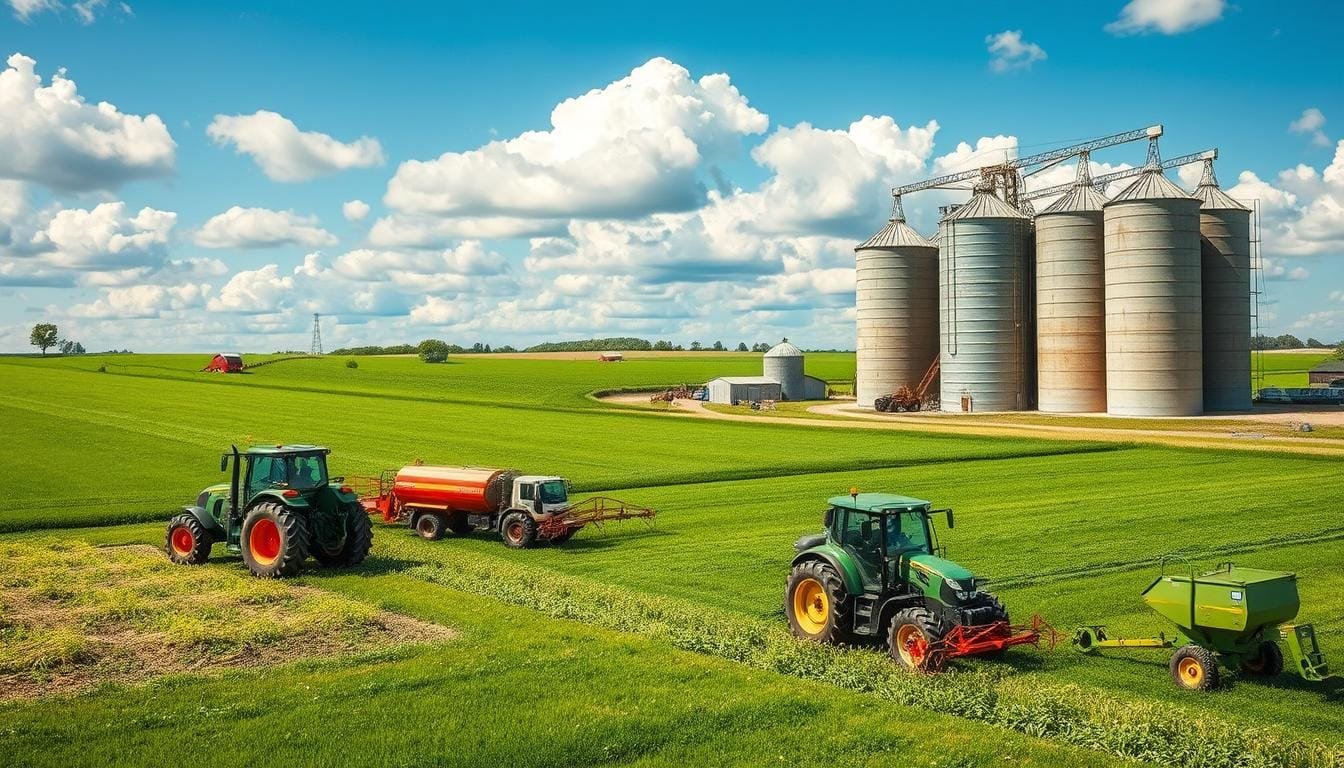How do capital goods influence the long-term sustainability of the agricultural sector?
In the world of agricultural economics, the role of capital goods is a hot topic. These assets, which include everything from farm buildings to complex machinery, livestock, and permanent crops, are crucial. They’re not used up in one production cycle, giving them lasting value that changes how we think about farming.
Capital goods form the core of farm asset management. They do more than just boost productivity. They’re key to both the immediate and future success of farms. You’ll find a range of capital goods in the field, like high-tech equipment, sturdy infrastructure, and strong livestock breeds.
Economic conditions around the world can greatly affect these goods’ value and role. Events like the Asian financial crisis and the drop in the Argentine peso show us how quickly costs and demand can change. Knowing all about capital goods and how they lose value over time is vital. This knowledge helps farmers make the best decisions for their operations.
Key Takeaways
- Capital goods in agriculture are vital for sustained agricultural productivity.
- Farm asset management relies heavily on durable assets like machinery and permanent crops.
- Global economic trends can dramatically impact the costs and demand for agricultural products.
- Depreciation and valuation of capital goods are crucial for effective agri-economic strategies.
- Understanding capital goods aids in both short-term gains and long-term farm sustainability.
Introduction to Capital Goods in Agriculture
Capital goods in agriculture are vital assets that last many production cycles. They include tools, machinery, and infrastructure known as agricultural production assets. These assets greatly increase farming productivity and economic efficiency.
It’s important to understand the capital goods definition for appreciating their role in agriculture. This category covers farm buildings, machinery, equipment, and livestock used in production. By investing in these assets, farmers can achieve sustainability and scale up their operations.
Investing in farm capital significantly impacts farm output. For example, from 2005 to 2015, the U.S. Midwest produced most of the nation’s corn and soybeans. This is largely because of investments in capital goods, which improved farming methods and resource use.
Agricultural production assets are crucial in the economy. Policies like the Renewable Fuel Standard (RFS), introduced in 2005 and expanded in 2007, affected commodity prices. Such policies show how external factors influence the demand for capital goods in agriculture.
Our research showed that short-term acreage changes are notable. But the general demand increase due to RFS means farm capital investments can change supply and stabilize prices. This reflects the dynamic nature of agricultural economics.
Capital goods differ from intermediate goods in agriculture. Tractors, silos, and irrigation systems, unlike intermediate goods, boost long-term productivity. Understanding this difference helps grasp the economic impacts of capital investments in farming.
Knowing the capital goods definition and their significance in farming is crucial. Through smart farm capital investments, farmers can greatly enhance productivity. Efficiency and economic strength also improve, ensuring sustainable and scalable farming practices.
Types of Capital Goods Used in Agriculture
In agriculture, the right capital goods are key for efficiency and growth. We’ll look at farm buildings, machinery, animals, and permanent crops. These are all vital assets.
Farm Buildings and Infrastructure
Farm buildings and agricultural infrastructure are crucial. They include barns, storage, greenhouses, and more. These are used for storing equipment and protecting crops. They support livestock too.
Things like water systems, fencing, and roads are also important. They help farms run smoothly.
Machinery and Equipment
Farm machinery and equipment are super important. Think tractors, harvesters, plows, and seed drills. These help with planting and harvesting. Good equipment makes farming easier and more productive.
Thanks to technology, farm equipment is now even better. It saves time and money.
Animals Used in Farm Operations
Agricultural livestock are a big part of farming. Animals like cattle, sheep, and chickens provide us with food and more. Their manure also makes the soil better.
Looking after these animals well is good for farming.
Permanent Crops
Permanent crops like orchards and vineyards are important too. They take time and money to start but pay off for years. They make farming more stable.
Knowing about these capital goods helps us use them better. This can lead to better farming.
Estimating Capital Costs in Agri-Economics
It’s vital to understand capital costs in farming for effective management. These costs impact how profitable a farm can be. They also show us smart ways to invest. Here, we explore how to figure out capital costs, looking at things like how assets lose value, missed profit chances, and extra costs of owning assets.
Economic Depreciation
How quickly farm assets lose value matters a lot. The USDA has been collecting cost and return data since 1975. This includes real costs from farmers. It’s different from guesses made before the fact, known as enterprise budgets. Take wheat in 2022 or corn and milk in 2021 as examples. Knowing these costs helps us work out how fast assets lose value.
Opportunity Cost of Capital
The chance cost of farming assets is about what you miss out on by investing here and not elsewhere. For example, corn might lose $22 for each acre, which is like 10 cents for each bushel lost. But in Indiana, in 2018, corn made $803 for every acre, after spending $456 on each acre. This shows why it’s important to think about chance costs.

Additional Ownership Costs
Don’t forget costs like insurance, taxes, and keeping things in good shape. These affect the total cost of owning farm assets. For example, soybeans made $636 per acre in Indiana in 2018. This was after spending $264 for each acre. A small rent increase made a big difference in costs. Managing these extra costs well is critical for making more profit.
| Commodity | Market Revenue per Acre | Total Variable Cost per Acre | Breakeven Price |
|---|---|---|---|
| Corn | $803 | $456 | $4.00/bushel |
| Soybeans | $636 | $264 | $10.05/bushel |
What Does Capital Goods Mean in Economics Corn and Soybeans?
The term capital goods in agricultural economics refers to machinery, durable crops, and buildings used in producing corn and soybeans. They are key in boosting efficiency and productivity. This affects the economy and the environment of the farming industry. Knowing about these assets is important for those in the corn and soybean fields.
For corn production, capital goods include tractors, planters, and harvesters. These are essential for running large farms efficiently. In soybean fields, we use combine harvesters, seed drills, and sprayers. These tools help in increasing the farm’s output and its economic health.

Capital goods in agriculture are more than just machinery. They also include silos, irrigation systems, and transport networks. These are vital for moving goods to the market. The table below compares the main capital goods in corn and soybean farming. It shows how important and useful they are:
| Capital Goods | Corn Production | Soybean Production |
|---|---|---|
| Primary Equipment | Tractors, Planters, Harvesters | Combine Harvesters, Seed Drills, Sprayers |
| Storage | Silos, Grain Bins | Silos, Grain Bins |
| Irrigation Systems | Sprinklers, Drip Systems | Sprinklers, Drip Systems |
| Transportation Networks | Trucks, Conveyors | Trucks, Conveyors |
Capital goods play a big role in corn and soybean farming’s economy. As technology grows and climate changes, these investments will be even more important. They help in keeping farming sustainable and profitable. By investing wisely in machinery and infrastructure, farmers can boost their productivity and profits.
Depreciation of Capital Goods in Agriculture
Depreciation plays a key role in managing agricultural assets. It helps estimate how much the value of assets drops over time. With depreciation models in agriculture, farmers can better plan their finances. We will look at common methods: linear, non-linear, and the declining balance approach.
Linear Depreciation
The linear depreciation, or straight-line method, is widely used in agriculture. The IRS describes it as deducting the salvage value from the cost and dividing by the asset’s lifespan. Consider a $10,000 machine with a $1,000 salvage value over 5 years. This would result in an annual depreciation of $1,800.
This method is simple and consistent, fitting well with various agricultural asset management plans. It gives a predictable yearly expense, important for budgeting.

Non-linear Depreciation
For tax reasons, non-linear depreciation like MACRS is used. MACRS’s GDS uses different periods for asset types and purchase years. For example, new farm machinery has a 5-year depreciation period in GDS and 10 years in ADS.
Non-linear methods are good for fast-depreciating assets, offering higher rates in early years. This helps farmers get bigger tax breaks sooner and manage depreciation better.
Declining Balance Approach
With the declining balance method, depreciation is fastest at the start. Take a $10,000 asset with the 200% declining balance method as an example:
| Year | Depreciation |
|---|---|
| 1st Year | $4,000 |
| 2nd Year | $2,400 |
| 3rd Year | $1,440 |
This approach is great for farm machinery that wears out fast in the first years. It enables farmers to save more at the beginning, aiding in efficient agricultural asset management as the asset gets older.
Drivers of Physical Capital Adjustments
Understanding physical capital adjustments is key for smart agricultural investments. These decisions are shaped by potential profit, societal impacts, and personal factors. Knowing this helps us grasp the process of farm capital adjustment and its wide effects.
Expected Profit
Expected profit greatly influences farmers’ investment choices. They weigh possible income against costs before making big investments. For example, GM corn brings in $1,488 per hectare while organic corn makes $2,793. Such comparisons guide farmers in choosing agricultural methods and technology.
Societal Benefits and Costs
Agriculture’s impact on society also affects capital decisions. It uses 38% of the world’s land and greatly aids the economy in developing countries. Yet, it’s also a major source of greenhouse gases and pollution. Balancing these societal pros and cons is key to encouraging sustainable farming.
Private Non-Pecuniary Benefits and Costs
Personal values and goals too play a role, though they’re more subjective. A farmer might opt for organic corn over GM corn for its health and environmental perks. This is despite it being more costly to produce—$455 per hectare for organic versus $775 for GM corn.
In conclusion, a deep dive into these investment drivers offers a full view of the farm capital adjustment journey. It encourages smarter, sustainable farming choices.
Conclusion
We’ve explored capital goods in agri-economics, showing their critical role in boosting farm productivity and sustainability. It’s key to grasp how these assets influence farm operations. This can help maximize profits and encourage sustainable farming.
We looked at important assets like farm buildings, machinery, animals, and permanent crops. It’s vital to correctly figure out the costs of these goods. This includes accounting for economic depreciation and other expenses. Plus, we talked about how depreciation methods affect asset values over time and the best management tactics.
We used real data on corn and soybean prices to showcase economic ups and downs in farming. For example, corn prices jumped to $6.89 per bushel in 2012 but are expected to drop to $4.25 by 2025. This is quite a change from the average price of $2.38 from 1974-2006. Soybean prices also showed a similar trend, with peaks and drops over the years.
These insights sum up the role of capital goods in farming, underlining the need for smart investment choices. Such choices are essential for financial health, especially when dealing with market changes. With this knowledge, farmers and other players can work towards more secure and successful farming approaches.
FAQ
What are capital goods in agriculture?
Capital goods in agriculture are assets used over many production cycles. These include things like farm buildings, machinery, livestock, and permanent crops. They are not used up in one production period but help in many cycles.
Why are capital goods important in agri-economics?
Capital goods are key for producing crops effectively. They help with both immediate production and long-term success. By boosting productivity, they make the agriculture sector more efficient and profitable.
What are some examples of farm buildings and infrastructure?
Important examples are barns, silos, greenhouses, and storage places. These buildings are vital for keeping crops and animals safe. They play a big role in farm operations.
How does agricultural machinery enhance productivity?
Machines like tractors and plows make farming easier. They do this by doing the work faster and better, lowering costs. This boosts how much food a farm can produce.
What role do animals play in farm operations?
Animals are a big part of farming. They provide meat, milk, and wool. They are valuable because they keep giving products over time, helping farms be more productive.
What are permanent crops and why are they significant?
Permanent crops, like orchards, don’t need to be replanted every year. They give crops for many seasons. This makes them very valuable, offering steady income to farmers.
What factors are included in calculating capital costs in agriculture?
Capital costs cover things like depreciation, opportunity costs, and extra costs such as insurance. Managing these costs well is important for a farm’s profits.
How do we calculate economic depreciation for agricultural assets?
You can calculate economic depreciation using different methods. These include linear, non-linear, and declining balance models. The choice depends on the asset and affects financial decisions.
What is the opportunity cost of capital in agriculture?
The opportunity cost of capital is about what else you could do with your money. It’s key in deciding where to invest in farming. This affects how you use your capital.
How do we incorporate additional ownership costs into farm economics?
Including costs like insurance and taxes in economic planning is essential. It helps farmers make smart choices about their investments and manage their resources better.
Why are capital goods significant in corn and soybean production?
For crops like corn and soybeans, tools and durable crops are crucial. They make growing these crops more efficient and cost-effective. This improves the financial results in these sectors.
What are the different methods of depreciating capital goods in agriculture?
There are several depreciation methods, including linear and non-linear. Each method is best for different kinds of assets. They help understand how much value assets lose over time.
What drives physical capital adjustments in agriculture?
Changes in physical capital depend on profit expectations, societal benefits, and personal gains. These factors motivate investment decisions, influencing farm productivity and future success.
How do societal benefits and costs impact agricultural investments?
Investments are shaped by societal interests like the environment and local communities. Finding the right balance between these elements supports sustainable farming practices.
